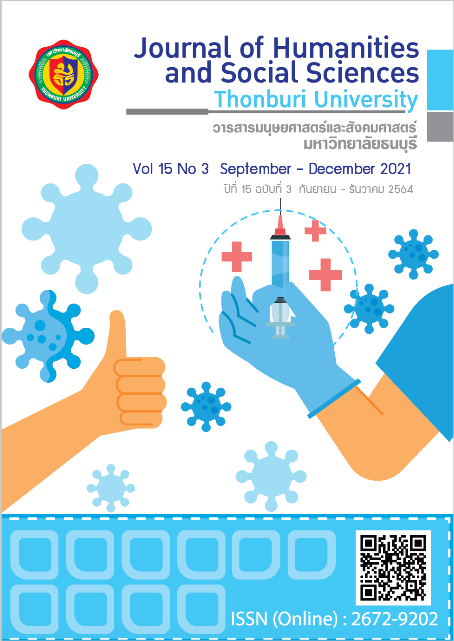Conceptual framework of antecedents and consequences of Enterprise risk management capabilities
Keywords:
Risk Management, Enterprise Risk Management, Enterprise Risk Management Capabilities, Antecedents and ConsequencesAbstract
Enterprise risk management is an important process in managing the organization's activities to prevent and reduce risks including manage risk to be within risk appetite and achieve the objectives of the organization. Therefore, organizations should be aware and emphasized the importance of Enterprise Risk Management Capabilities. This article provides the concept, the antecedents and consequences of Enterprise Risk Management Capabilities including the influence of moderators that have an effect on the relationship by reviewing literature from various sources such as textbooks, academic articles, research articles and publications of the public and private sectors. This article would be useful for applying this concept in organizations and being the guideline of empirical research in the future.
References
พันทิวา สุพัฒนาภรณ์. (2556). ภาวะผู้นำที่ส่งผลต่อวัฒนธรรมองค์กร กรณีบริษัทไทยอกริฟู้ดส์ จำกัด (มหาชน). ศิลปศาสตร มหาบัณฑิต, สถาบันบัณฑิตพัฒนบริหารศาสตร์.
สุวิมล บัวทอง และศิริลักษณ์ บางโชคดี. (2558). การใช้ตัวชี้วัดผลการดําเนินงานทางการเงินและ ไม่ใช่ทางการเงินภายใต้ทฤษฎีการบริหารเชิงสถานการณ์. วารสารวิชาชีพบัญชี. 11(31): 63-798.
Barney, J. (1991). Firm Resources and Sustained Competitive Advantage. Journal of Management. 17(1): 99-120.
Chen, X. and Zhang, X. (2016). How Environmental Uncertainty Moderates the Effect of Relative Advantage and Perceived Credibility on the Adoption of Mobile Health Services by Chinese Organizations in the Big Data Era. International Journal of Telemedicine and Applications. 2016: 1-11.
COSO. (2004). Enterprise Risk Management - Integrated Framework. Committee of Sponsoring Organizations of the Treadway Commission, New York, NY.
_______. (2017). Enterprise Risk Management Integrating with Strategy and Performance. Committee of Sponsoring Organizations of the Treadway Commission, New York, NY.
_______. (2020). Creating and Protecting Value: Understanding and Implementing Enterprise Risk Management. Committee of Sponsoring Organizations of the Treadway Commission, New York, NY.
Esa, M. and et al. (2018). Impact of Enterprise Risk Management on Organizational Performance. Journal of Advanced Research in Dynamical and Control System. 10(6): 190-197.
Fiedler, E. F. (1967). A theory of leadership effectiveness. New York: McGraw-Hill
Galavan, R. J. (2015). Understanding Resources, Competences, and Capabilities in EU Common Security and Defense Policy (Working Paper). 1-20.
Ghazzawi, K., Shoughari, R. E., Osta, B. E. (2017). Situational Leadership and Its Effectiveness in Rising Employee Productivity: A Study on North Lebanon Organization. Human Resource Management Research. 7(3): 102-110.
Ibrahim, F.S. and Esa, M. (2017). A Study on Enterprise Risk Management and Organizational Performance: Developer’s Perspective. International Journal of Civil Engineering and Technology. 8(10): 184–196.
Inayah, A.K. and Balqiah, T.E. (2017). THE INFLUENCE OF LEADERSHIP STYLE AND ORGANIZATIONAL CULTURE IN THE IMPLEMENTATION OF RISK MANAGEMENT. 3rded. Parahyangan International Accounting and Business Conference 2017. 405-421.
Iswajuni, I., Manasikana, A. and Soetedjo, S. (2018). The effect of enterprise risk management (ERM) on firm value in manufacturing companies listed on Indonesian Stock Exchange year 2010-2013. Asian Journal of Accounting Research. 3(2): 224-235.
Kirilmaz, O. and Erol, S. (2017). A proactive approach to supply chain risk management: Shifting orders among suppliers to mitigate the supply side risks. Journal of Purchasing and Supply Management. 23(1): 54-65.
Kopia, J. (2017). Meaning and Usage of a Conceptual Enterprise Risk Management Framework–A Case Study. Ecoforum. 2(11): 1-10.
Lungu, M.F. (2020). The influence of strategic agility on firm performance. Proceedings of the 14th International Conference on Business Excellence2020. 102-110.
Nafei, W. A. (2016). Organizational Agility: The Key to Organizational Success. International Journal of Business and Management. 11(5): 296-309.
Oyewobi, L.O., Windapo, A.O., and James, R. O. B. (2015). An empirical analysis of construction organizations’ competitive strategies and performance. Built Environment Project and Asset Management. 5: 417–31.
Porter, M.E. (1985). Competitive Advantage: Creating and Sustaining Superior Performance, The Free Press, New York, NY.
Purchase Control. (2019). Proactive Risk Management – Identifying and Avoiding Risks. Retrieved June 10, 2020, from https://www.purchasecontrol.com/blog/proactive-risk-management-approach/
RM studio. (2019). Cultivating a Risk Aware Culture. Retrieved Feb 18, 2021, from https://www.riskmanagement studio.com/risk-aware-culture/
Saeidia, P. and et al. (2019). The impact of enterprise risk management on competitive advantage by moderating role of information technology. Journal of Computer Standards & Interfaces. 63: 67-82.
Samsami, F., Khodadad, H., Kordnaeij, A. and Azar, A. (2015). Managing Environmental Uncertainty: From Conceptual Review to Strategic Management Point of View. International Journal of Business and Management. 10(7): 215-229.
Silva, M.Z. and Fernandes, C.F. (2019). The influence of contingencies factors strategy and structure in the enterprise risk management in a hospital. Gestão & Produção. 26(1): 1-16.
Singh, N.P. (2019). Managing environmental uncertainty for improved firm financial performance: the moderating role of supply chain risk management practices on managerial decision making. International Journal of Logistics Research and Applications. 23(3): 270-290.
Song, F. and Thakor, A.V. (2018). Bank culture. Journal of Financial Intermediation. 39: 59-79.
Teece, D.J., Peteraf, M.A. and Heaton, S. (2017). Dynamic Capabilities and Organizational Agility: Risk, Uncertainty and Entrepreneurial Management in the Innovation Economy. California Management Review. 1: 1-33.
Tomal, D.R. and Jones, K.J. (2015). A comparison of core competencies of women and men leaders in the manufacturing industry. The Coastal Business Journal. 14(1): 13-25.
Yang S, Ishtiaq, M. and Anwar, M. (2018). Enterprise Risk Management Practices and Firm Performance, the Mediating Role of Competitive Advantage and the Moderating Role of Financial Literacy. Journal of Risk and Financial Management. 11(35): 1-17.
Zou, X and Hassan, C.H. (2017). Enterprise risk management in China: the impacts on organizational performance. International Journal of Economic Policy in Emerging Economies. 10: 226–39.
Translated Thai References
Buathong S. and Bangchokdee S. (2015). Use of Financial and Non-Financial Performance Measures within Contingency Theory. Journal of Accounting Profession, 11(31): 63-798. (in Thai)
Suphatthanaporn P. (2013). The Leadership affect to the Organizational Culture: The case of Thai Agri Foods Public Co., Ltd.. (Master of Arts (Applied Communication) Thesis, National Institute of Development Administration). (in Thai)







